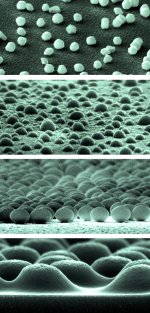Welcome to AltaLuz Project
Citizens’ awareness about the need to foster sustainable and environmental-friendly energy sources has been creating value and encouraging investment in “clean” efficient technologies such as photovoltaic (PV) power generation.
Most commercially available solar cells consist of a wafer-based crystalline silicon (c-Si) p-n junction. Nowadays, besides costs, this technology is approaching its practical and theoretical efficiency limits. Further PV development will only be possible by reducing costs and pushing efficiencies beyond the limits of conventional mono-junction cells. This implies the conception of inexpensive thin-film (TF) devices able to reach efficiencies above those (~20%) of current commercial cells, to make them market competitive. To achieve such target, ALTALUZ will explore industry-oriented scientific creativity in 3 key areas:
1) Device architecture – an innovative strategy will be developed to construct double-junction TF cells by fabricating each subcell separately, with independent contacts (see Fig.1), and then stacking them to form 4-terminal tandem devices. The bottom subcell will be made of microcrystalline Si, due the adequate low bandgap and maturity of such technology.
2) Materials development – Promising PV materials will be investigated for the top cell, employing wide-bandgap semiconductors made of organo-metal halides (Perovskites) and kesterites (CTZS). Novel materials will also be developed for the interface between the bottom and top cell, to allow a precise bonding of the subcells, electrically isolate them and minimize the optical losses within the stack.
3) Photonics – light trapping (LT) strategies will be employed to enhance the photocurrent spectra of the devices, by applying advanced nano-optical concepts and combining different photonic structures at distinct locations in the stack. The key challenge is to translate previous results for LT in single-junction cells to the more difficult problem of wavelength-selective LT in a tandem cell.
A combined strategy covering these areas will produce major advancements in the state-of-art, thereby strengthening Portugal’s role in PV, unlocking opportunities for industry and reinforcing our position concerning the societal challenges Europe is facing. The development of TF cells is particularly important at this time, especially given the European financial crisis. The crisis has been tampering the PV market development particularly in the implementation of large PV power plants, which require important capital expense. Therefore, nowadays it makes more sense the growth of PV in distributed autonomous systems, with low-cost non-wafer-based devices which can be supported on a wide variety of rigid (glass, building facades and rooftops [1], etc.) or flexible (plastics, paper-based, etc.) inexpensive substrates; thereby also extending PV solutions to a wider range of consumer-oriented applications.
ALTALUZ will develop a new tandem cell architecture consisting in stacking independently-connected cells in a double-junction. Such approach allows the subcells to be fabricated and optimized separately, and improved by the combined action of light scattering elements able to trap the light in their photoactive regions. Distinct types of PV materials and light management structures will be investigated, bringing together recent advances in TF PV, photonics and materials research, which should open the way for the production of low-cost cells with record efficiencies reaching 30%. All the proposed technologies have in common a better exploitation of the solar spectrum using inexpensive Earth-abundant materials, following approaches that are compatible with the mass-manufacturability requirements of present-day PV industry.
This proposal is not blue sky, as the theory behind it is solid and most of the means to develop it in practice will involve available equipment and methods within the expertise of the partners. Therefore, high impact results are expected if some of the proposed approaches can lead to such high efficiency.
The project will foster a new collaboration between two top R&D centers, in the areas of materials science, nanotechnology and PV, aimed at implementing a revolutionary generation of solar cells not predicted by PV roadmaps. The researchers involved have notorious internationally-recognized expertise in different PV-related areas and broad complementary formation and facilities required for the project’s success. The wide range of interrelated concepts and techniques to be investigated, and the broad spectrum of scientific know-how, places ALTALUZ at the cutting edge of current research in PV.
Training and integration of young researchers is also a key ingredient in the project, with 55% of budget allocated to their financial support.

 Light trapping nanostructures
Light trapping nanostructures